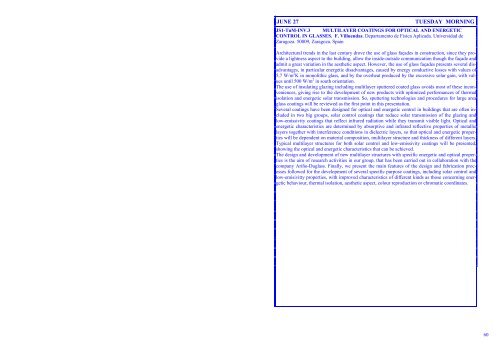Wüest M. 51 Wykes M. 82 Yamaguchi M. 17 Ybarra G. 129 Yubero F ...
Wüest M. 51 Wykes M. 82 Yamaguchi M. 17 Ybarra G. 129 Yubero F ...
Wüest M. 51 Wykes M. 82 Yamaguchi M. 17 Ybarra G. 129 Yubero F ...
Create successful ePaper yourself
Turn your PDF publications into a flip-book with our unique Google optimized e-Paper software.
JUNE 27 TUESDAY MORNING<br />
JS1-TuM-INV.3 MULTILAYER COATINGS FOR OPTICAL AND ENERGETIC<br />
CONTROL IN GLASSES. F. Villuendas. Departamento de Física Aplicada. Universidad de<br />
Zaragoza. 50009, Zaragoza. Spain<br />
Architectural trends in the last century drove the use of glass façades in construction, since they provide<br />
a lightness aspect to the building, allow the inside-outside communication though the façade and<br />
admit a great variation in the aesthetic aspect. However, the use of glass façades presents several disadvantages,<br />
in particular energetic disadvantages, caused by energy conductive losses with values of<br />
5,7 W/m 2 K in monolithic glass, and by the overheat produced by the excessive solar gain, with values<br />
until 500 W/m 2 in south orientation.<br />
The use of insulating glazing including multilayer sputtered coated glass avoids most of these inconveniences,<br />
giving rise to the development of new products with optimized performances of thermal<br />
isolation and energetic solar transmission. So, sputtering technologies and procedures for large area<br />
glass coatings will be reviewed as the first point in this presentation.<br />
Several coatings have been designed for optical and energetic control in buildings that are often included<br />
in two big groups, solar control coatings that reduce solar transmission of the glazing and<br />
low-emissivity coatings that reflect infrared radiation while they transmit visible light. Optical and<br />
energetic characteristics are determined by absorptive and infrared reflective properties of metallic<br />
layers together with interference conditions in dielectric layers, so that optical and energetic properties<br />
will be dependent on material composition, multilayer structure and thickness of different layers.<br />
Typical multilayer structures for both solar control and low-emissivity coatings will be presented,<br />
showing the optical and energetic characteristics that can be achieved.<br />
The design and development of new multilayer structures with specific energetic and optical properties<br />
is the aim of research activities in our group, that has been carried out in collaboration with the<br />
company Ariño-Duglass. Finally, we present the main features of the design and fabrication processes<br />
followed for the development of several specific purpose coatings, including solar control and<br />
low-emisivitty properties, with improved characteristics of different kinds as those concerning energetic<br />
behaviour, thermal isolation, aesthetic aspect, colour reproduction or chromatic coordinates.<br />
60
















